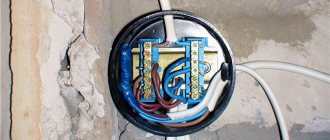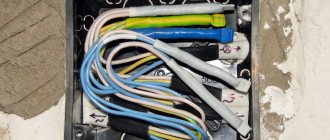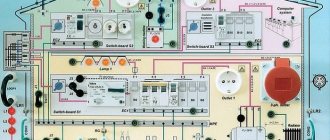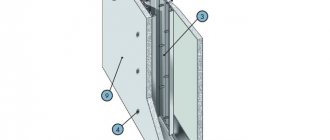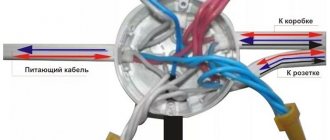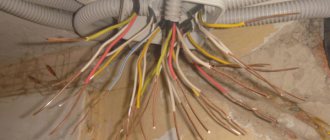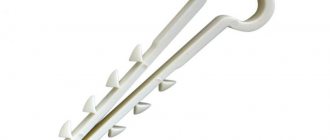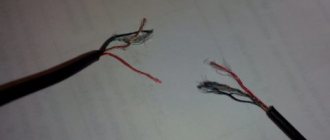Today, manufacturers supply many different electrical products to the construction market. Let's look at what the junction box is used for. Let's get acquainted with the criteria for selecting products depending on the purpose and operating conditions. Read to the end and you will find out what must be taken into account for the proper installation of electrical communications inside or outside the building, in dry, dusty or damp rooms.
Variety of electrical junction boxes Source sellpax.com
Classification by type
Depending on the purpose, these switching products can be divided into the following types:
- branch boxes for switching wire broadcasting lines (UK-2P and UK-2R);
Photo of UK-2P with the cover removed
- branch boxes with a standard size of 100x100x50 mm (KTO-100, KT-100, KM-100, KS-100, KU-100, KO-100, etc.), designed for household open and hidden wiring. Note that models are also available in sizes different from the standard;
Photo of the DKC (DKS) branch box for open wiring
- Branch-type boxes designed for switching cable lines (can be installed on UHL systems), with an operating voltage of no more than 1 kV, for example, KOR-73U3, U197, U994, U997M, KVP, KRP, KOS, etc. Note that the designation “U” indicates that the box is universal, “M” is made of metal.
This category also includes: a distribution box for the busbar trunking (SHB), a cable box for overhead lines and a pull-through box.
The photo shows a tee (that is, with three cable entries) branch box type U409
Is it always needed?
A completely logical question: is it possible to do without a junction box? Purely theoretically, yes.
Now imagine that from the input electrical panel, which is usually located at the entrance to a house or apartment, you will need to extend a separate line to each switch and socket. How much wire will you need then? And the grooves will have to be made wide and deep so that several wires can be laid in them. So from a purely economic point of view, installing distribution boxes is a rational and expedient solution.
Someone might object and say that it is much safer to lay a solid line from the electrical panel to the switch or outlet, and there will only be an extra connecting node in the box. There is only one answer to this - a correctly and competently executed connection of wires does not pose any danger.
Everyone can have their own opinion on this matter, however, today the option using distribution boxes is the most preferable.
Protection class
The main characteristics of branch boxes also include the protection class (GOST 14254-96), which is indicated as IPXX, where XX is a digital designation. Moreover, the first number indicates resistance to dust, the second - to moisture. Below are tables that list the protection class codes.
Table for the first digit:
| Code | Description |
| no protection provided | |
| 1 | penetration of particles larger than 50 mm is not allowed |
| 2 | penetration of particles larger than 12 mm is not allowed |
| 3 | penetration of particles larger than 2.5 mm is not allowed |
| 4 | penetration of particles larger than 1 mm is not allowed |
| 5 | The device is protected from dust deposits |
| 6 | The device is protected from dust penetration |
Table for the second digit:
| Code | Description |
| no protection provided | |
| 1 | The device is protected from vertically falling drops, such as condensation |
| 2 | The device is protected from drops falling at an angle of up to 15° |
| 3 | The device is protected from drops whose angle of incidence does not exceed 60° |
| 4 | Provides comprehensive protection against drops and splashes |
| 5 | comprehensive protection against water jets |
| 6 | comprehensive protection against high-pressure water jets |
| 7 | The device is protected from water penetration during short-term immersion to a depth of one meter |
| 8 | The device is completely sealed (can be used underwater) |
Using this table, you can easily determine the operating conditions of the device, for example, if the protection class IP65 is indicated on the branch box, this indicates that the device is completely protected from dust and does not allow moisture to enter when a jet of water hits it.
Choices for Home Wiring
Household distribution boxes must be selected based on the type of wiring:
- if it is hidden, then built-in models will be required;
- for external wiring - overhead branch boxes (that is, installed on the wall).
You should also not get carried away with the high class of protection; it is unlikely that an explosion-proof or completely sealed distribution (junction) box will be needed in everyday life. The latter, however, can be useful if a street power network is being laid, for example, to illuminate the area near the house.
Why are they called differently?
The electrical connection box has received several names at once - distribution, junction, branch, switch.
It is like an electrical distribution point, which receives voltage from a power source, and then disperses along several electrical branches - to sockets, switches, and lighting fixtures. Because the voltage in the box is distributed in different directions, it is called distribution. Since several electrical branches extend from the box, a synonym has appeared - branch.
Another name comes from the way the wires are connected inside the box. For a long time, soldering was considered the most reliable method. At the junctions, the wires were twisted and then soldered, due to which electricians began to call the boxes unsoldered.
In an interesting way, another synonym arose - exclusion box. The word “disconnection” can only be heard among professional electricians, and they came up with it, as if combining two concepts - distribution and connection. That is, they distributed in the box which wire should go where, and then connected them according to the diagram.
Now there are so many modern connection options - all kinds of terminal blocks, welding, insulating connecting clamps, sleeve crimping, terminal blocks, self-clamping terminals. However, boxes are still often referred to as breakout boxes.
We explained all this to you so that when you go to choose materials in electrical goods stores and see different names in different places, know that they all mean the same junction box.
Installation
We remind you that all wiring work must be performed only when the power supply is turned off.
The process of installing overhead distribution boxes is not difficult; just mark the holes for the fasteners, drill them and fix the base to the wall, having previously removed the plugs for pipes or cable boxes from it. Next, it is enough to connect the wires as required by the wiring diagram.
Photo of installed and connected external junction box
If the box is metal, it is advisable to ground it (when grounding is provided in the wiring).
Before turning on the power, we recommend that you carefully check that the connections are correct.
Video: Typical mistakes when desoldering a branch or distribution box.
The process of installing a distribution box for hidden wiring is somewhat more complicated. For this purpose, you will need a special attachment for the hammer drill if you want to create a seat in concrete or brick. For drywall, the attachment can be installed on a regular non-impact drill.
Nozzle for concrete Nozzle for drywall
Having selected a nozzle that matches the diameter of the glass box, proceed to drilling a hole. When working with concrete, we recommend using a respirator when drilling.
Further, the installation algorithm depends on the wall material:
- for drywall, it is enough to pull out the drilled circle, install the glass and secure it with fasteners;
- in a concrete or brick wall you will need to knock out a drilled hole (its edges should be smooth) and install a glass, fixing it with cement or gypsum mortar.
Further, the process is practically no different from the actions when installing the external box, which was described above.
Box installed in a brick wall
The picture above shows the branch box installed and connected.
KSR-6-400, KS-10-630 are designed for connecting flexible cables (4 and 5 cores) of drilling machines and excavators during open-pit mining in three-phase current networks with an insulated neutral voltage of 6 (10 for KS-10- 630) kV. The steel walls of the junction box with a thickness of 4 (5 for KS-10-630) mm reliably protect the connecting elements from mechanical damage and exposure to the surrounding atmosphere. Special slides allow it to be moved by dragging and provide additional protection from rain and snow. The lid can only be opened with a special key, which prevents unauthorized opening by unauthorized people. The mechanism for blocking the opening of the lid provides for preliminary removal of voltage from the knives and removal of residual charges from the capacitances of the cable phases. Operating conditions of the junction box:
Wiring diagrams
It is necessary to become more familiar with the features of connecting the wiring from the junction box to consumers.
Prices for various types of voltage indicators
Voltage indicator
Connecting sockets
Often sockets are connected in groups on one line. So, 3 cables with several conductors are placed inside the box. Brown indicates the phase conductor, blue indicates neutral, and green or yellow indicates ground. Of course, some manufacturers use other colors.
Connecting sockets
The wires are laid out on a flat surface, and then cut to a certain length, but with a margin (so that it can be separated again). Next, it remains to fix them according to the diagram.
Connecting a switch with one button
This is where installation becomes more complicated. After all, there are three groups of electrical wiring with different connections. One conductor is responsible for supplying voltage from another box or panel, the second comes from the lighting fixture, and the third from the switch.
The phase conductor is fed to a switch, which is connected to the lamp. Here you should make sure that the voltage supply occurs precisely when the switch is closed. The neutral and grounding conductors from the lamp are connected to the shield.
The principle of connecting a switch with one button
Connecting a switch with two buttons
A three-core cable is connected to this type of switch (without a grounding conductor, because it is connected directly to the panel). The first conductor goes to the common contact of the switch, the second to the first button, and the third to the second button.
Note! The phase conductor is connected to the common contact, the zero is fixed directly from the board and lamps. The phase wires from the lighting fixtures are fixed with the cores on the buttons.
Connecting a switch with two buttons
Junction box: what is the purpose
This junction box has many names, such as junction box or junction box. It receives the main voltage from the source, and then it is distributed along separate electrical lines - to a socket or switch.
This point allows you to get easy access to wire connections, check their correctness and make corrections to faulty nodes, as can be seen from the photo of the junction box.
If you draw a line directly from the panel, it will be labor-intensive; additional gating of the walls will be required, and the use of a large amount of cable. And in the event of a fire or damage to the connections, you will not need to open the wiring. You can quickly check the integrity of the electrical connections by opening the branch block.
Some may think that the presence of such a compartment will not fit into the interior, it will stand out against the background of the wall or require a lot of effort.
But there is always the opportunity to aesthetically design the lid and decorate it to match the chosen style of the room. The effort and time spent will pay off in the future.
General description of products
Engineering communications are a network of a central channel, branches, and end points. For the system to function properly, it is necessary to form reliable nodal connections of individual elements. In the case of electrical wiring, the event is carried out using electrical junction boxes.
In fact, the device is represented by a box with a lid. Install it at each node branch. The main goal here is to isolate contact connections from possible environmental influences and unauthorized mechanical influence. It also protects the premises from fires during a short circuit and protects people from electric shock. Additionally, two problems are solved: access to contact nodes for various purposes, and a decorative component.
Installation method
Depending on what type of distribution box is used and how it is installed, external and internal boxes are distinguished.
A box designed for open-type wiring (external installation) is placed directly on the wall plane. There is no need to drill the base in advance, since the mounting is done on the wall using fastening devices.
For indoor installation, models with hidden wiring are used. They are placed in a pre-equipped cell, which is drilled, for example, with a drill with a crown. In drywall and other softer sheet materials, the installation site must be carefully cut out.
Where is the distribution box installed?
Most often, they prefer to install the junction box under the ceiling at a distance of approximately 25 centimeters from it. This is associated with the safety of using electrical wiring, because the possibility of the protective cover falling off cannot be ruled out, which will cause electric shock to a person.
Junction boxes are fixed at height
Note! Another reason for accurately calculating the location of the box is the cable consumption for network wiring. Therefore, the closer you can bring the conductor to the consumer, the shorter the branch from the box to this point will be.
Prices for popular models of wall chasers
Wall chaser
Material
When choosing, you should focus on durable and fireproof material, characterized by a high level of heat resistance. Most often on sale you can find plastic models made of polyamide, polypropylene or cast fluoroplastic. Such products will not decompose under the influence of active compounds.
The boxes are quite durable and have good insulating characteristics. Unlike metal samples, they are more resistant to wet conditions. When ignited, the plastic does not burn, but begins to melt.
Types of distribution boxes
Distribution boxes are divided according to the following characteristics:
- by composition and raw materials used. Most boxes are made of metal using PVC;
- by type: oval, square, round;
- IP cover level of protection (without protection, with protection, sealed);
- by the method of inserting wires into the box. Also, the walls can be smooth with or without holes;
- by closing method: with adjustable lid, regular lid;
- The installation method can be hidden or open.
Types of products by size
Please note! There is some confusion in the naming of wiring boxes. A junction box is sometimes understood as a socket box, so people don't see the difference, but they are different things.
Invoices
This type of box is installed on the wall. The product for hiding cables is practical because, if necessary, you can quickly find the point where the wires are connected.
Surface mounted type IP42
This installation method is used in industrial plants and offices, that is, in places where there are a large number of electrical energy consumers. In private homes, the distribution overhead box can be mounted in the utility room.
You may be interested in: Power withstand with a wire with a cross-section of 25
Domestic
Hidden wiring is installed in residential premises; the wires are laid in special cable channels and hidden behind the plaster. Such a distribution box is mounted in a pre-prepared trench in the wall, and cable grooves come from it. In this case, it can be installed either in a solid brick or concrete wall or in plasterboard.
When wiring is hidden, the cables are hidden in the wall
Dimensions and shape
The dimensions of distribution boxes are determined by operating conditions. The number of inputs, the safety class, and the purpose of use are affected. For an apartment, you need to choose products more than 100 mm in diameter with 2-4 inlet holes.
The largest number of inputs that can be equipped is 16, but at the same time the dimensions of the width and depth of installation will increase.
Boxes can be round or square, and rectangular samples are also available. When working with external wiring, this factor has no technical significance, and the choice is determined by the aesthetics of the fastening. But for internal installation, it is easier to use a round structure, since a hole of this shape is much easier to drill.
Methods for connecting wires in a junction box
There are several basic ways to connect the wiring in a junction box. In order to choose one of them, you need to consider the options in more detail.
Stranding and insulation
This is an old, but proven method of connecting wiring over the years. The bottom line is that the ends of the conductors are first stripped of the insulation layer and then twisted together with pliers. After which this place is wrapped with electrical tape.
Twisting conductor strands
This method has advantages:
- ease of installation;
- no need for additional expenses.
However, there are some disadvantages:
- poor-quality connection of cores;
- inability to connect copper and aluminum wires.
It is worth noting that conductors are often connected in this way during temporary installation of electrical wiring. According to safety regulations, the connection method is not suitable for rooms with high humidity levels.
Soldering or welding
It is in these ways that you can make a durable connection of wiring cores. First, their ends are carefully stripped of the insulating layer, then twisted, but without effort. Next, you will need to solder the wires using solder and a soldering iron so that they turn out monolithic. Then you need to wait until they cool naturally, and only then wrap them with electrical tape.
Soldering wire cores
In cases of soldering thick wires, you will need to use a soldering iron with a dense copper tip.
Note! Some would-be craftsmen do not want to wait for the veins to cool naturally, so they cool them under running water. However, this should not be done - microcracks will appear on the surface.
The advantage of soldering is the reliability of the connections, but this method also has some disadvantages:
- the need to purchase a soldering iron;
- this is a labor-intensive process that not every beginner can handle;
- the connection is permanent;
- Over time, the level of resistance in the soldering increases, which leads to voltage leakage.
Often, instead of soldering, the cores are connected by welding. The process has a similar principle, only here a welding machine is already used, so the master must have the appropriate skills.
Video - Soldering twists
Crimping with sleeves
This is also one of the most reliable methods of fixing conductor cores. Here they are placed in a special sleeve and clamped with a crimping tool on both sides. After which this sleeve is wrapped with electrical tape or a cambric is attached to it.
Crimping of conductor cores
It is worth noting that the cores are placed in the sleeve either from different sides or from one. In the case of the first option, they will be connected in the central part of the tube. When choosing the second option, it is necessary to take into account that the diameter of the cores should not exceed the volume of the sleeve.
The advantages of such a connection should be noted:
- reliability;
- affordable cost of sleeves.
Disadvantages of the method:
- The sleeve is used only once. This means that in case of repair, it is torn down and a new one is fixed.
- You will need to use a special tool for high-quality crimping on all sides.
- Wires made of aluminum and copper are crimped only with special tubes, which are difficult to find in stores.
- Electrical installation will take time.
Terminal connection
If the wiring is made of different materials, it is recommended to use special clamps with springs or screws. Connecting the conductors using this method is not difficult; all you need is a screwdriver. The main thing is not to overtighten the bolts.
Connecting wires with clamps
Degree of protection
These switches not only play a role in simplifying electrical installation work, but also ensure operational safety. Therefore, the connection of wires in the junction box must be reliably protected.
Product class should be taken into account:
- in rooms without humidity, samples IP 20 and IP 30 are used;
- outdoors and in wet rooms with canopy protection from direct exposure to water, IP 44 is used;
- complete protection from moisture and precipitation - class IP 55. This option is often used for household electrical installations;
- outdoors, in the ground, IP 67 is used;
- use with underwater diving – IP 68.
Briefly about the main thing
Distribution boxes are used to hide contact connections of conductors from contamination, moisture, and physical impact. Open access to nodes is also provided.
The boxes differ in design, installation method, application, material and permissible operating conditions.
Additionally, products can be equipped with rubber seals, covers, terminals and clamps, and fasteners.
According to the degree of protection, open boxes (socket boxes) are distinguished that protect contacts from dust, moisture or fire, and are permissible for immersion in the ground or in a body of water.
